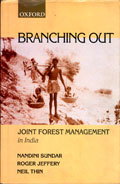Gaps galore
 This book is a welcome addition to the growing literature on the joint forest management (JFM) programme. The beginnings of this initiative can be dated to the early 1970s, when people had just begun to question the 'industrialise at all costs' policy. However, it took another decade and a half before the difficulties of official forest management that excluded people from protected areas were widely recognised. Meanwhile, the official JFM initiative, with beginnings in Arabari, had yielded fruit. There was widespread emulation of this initiative. These developments catalysed the 1988 National Forest Policy Resolution, the first explicit indication that India's forest policy was changing.
This book is a welcome addition to the growing literature on the joint forest management (JFM) programme. The beginnings of this initiative can be dated to the early 1970s, when people had just begun to question the 'industrialise at all costs' policy. However, it took another decade and a half before the difficulties of official forest management that excluded people from protected areas were widely recognised. Meanwhile, the official JFM initiative, with beginnings in Arabari, had yielded fruit. There was widespread emulation of this initiative. These developments catalysed the 1988 National Forest Policy Resolution, the first explicit indication that India's forest policy was changing.
In his 1988 speech to the Lok Sabha, the minister for environment and forests used a completely new vocabulary, speaking of generating forest-based employment. This was followed by a letter on June 1, 1990 from the central ministry of environment and forests suggesting that the state forest departments work out joint management agreements with local communities.
These developments decidedly marked a watershed in the officially-accepted forest policy. They were widely welcomed, at least by non-governmental organisations (NGOs), academics and donor agencies, if not by the forest-dependent communities themselves. As a result, the last 12 years have seen a flurry of activities, including an outpouring of literature on the topic of JFM.
The discourse in this literature has, in many ways, been unduly restrictive. It has been focussing on micro-enterprises in management of forest patches at the village level, rather than looking at higher-level forest management and economic processes. The emphasis has been on the bare bones of participatory development - new rules, one-off participatory planning events, village committees - rather than broader and longer term processes such as the management of trade-offs among diverse objectives, and the need for scaled-up participation. Production of trees, tree products and fodder have been the highlight, with broader ecological processes and debates about alternative uses and competing rights and responsibilities being given the go-by. Inter-agency partnerships have also not found a major part in the discourses.
The book under review begins by identifying these gaps in the existing literature. It then sketches a research programme carried out between 1995 and 1997 that attempted to take a broader view and arrive at an understanding of these issues. The programme was a joint effort of the Institute for Economic Growth at University of Delhi and the departments of sociology and anthropology at the University of Edinburgh, involving over 11 researchers. It was grounded in a substantial amount of fieldwork in four villages each in the Rajpipla forest division in Gujarat, Dewas forest division in Madhya Pradesh, Paderu forest division in Andhra Pradesh and Sambalpur forest division in Orissa.
The choice of these divisions permitted representation of a range of variables, including the length of time that JFM or other forms of local involvement in forest management had been practiced, ethnically homogeneous or heterogeneous areas, presence of NGOs and attitudes of the forest departments. The research undertaken is notable for its sensitivity to issues of social, political, economic and gender inequalities, and involved working with village communities, NGOs, forest departments and donor agencies.
The material is organised into six chapters, with the introductory chapter providing the broader setting. This is followed by a description of the research sites at the state, division and village levels. Chapter three considers the experience of JFM from the three-fold perspectives of community, power relations and choices available.
The next chapter considers the different ecological regimes and the dominant forest types of the four forest divisions, and past systems of management and access. This chapter highlights the fact that JFM does not represent a significant departure from conventional forestry. Chapter five moves beyond the village level, and asks three sets of questions: what is the evidence of a change in the attitude of the forest department staff and their relationships with the local people and NGOs? What kinds of relationships have developed between NGOs and forest department staff, and to what extent can NGOs contribute to JFM? Finally, what are the intentions of international donor agencies? How far have they been able to influence the processes of change?
The concluding chapter confronts the question of divergence between explicit and implicit policy. An answer to the last question is that it is too early to be sure. The forest bureaucracy has been attempting, with considerable success, to take advantage of JFM and create free labour for its own programmes. Nevertheless, there are signs that JFM may eventually turn out to be part of a broader progressive development. While we wait and watch, this well-researched, well-written book provides an excellent guide to this much talked about experiment.
Madhav Gadgil teaches at the Centre for Ecological Sciences, Indian Institute of Science, Bangalore.
